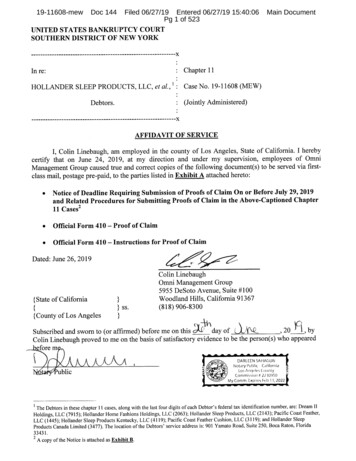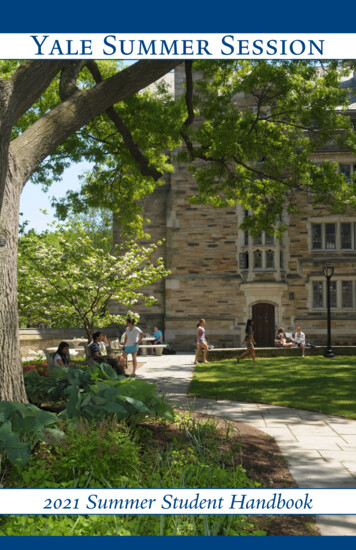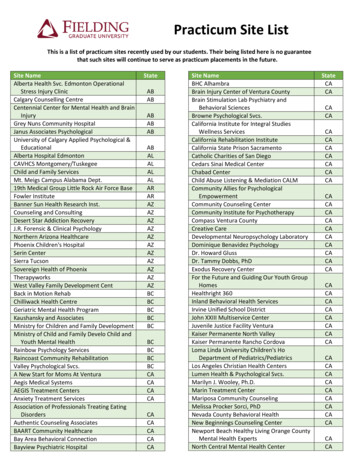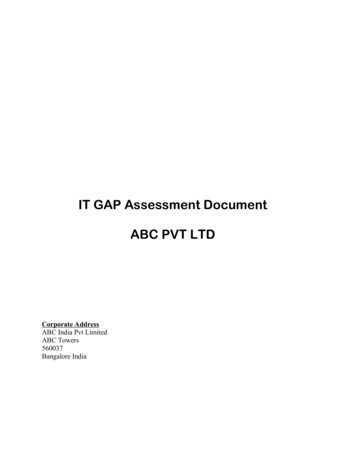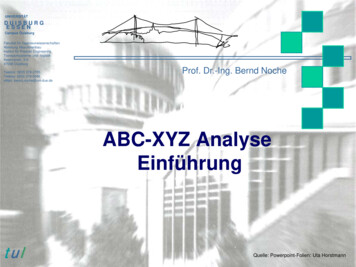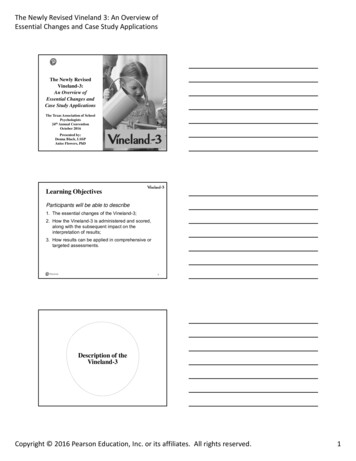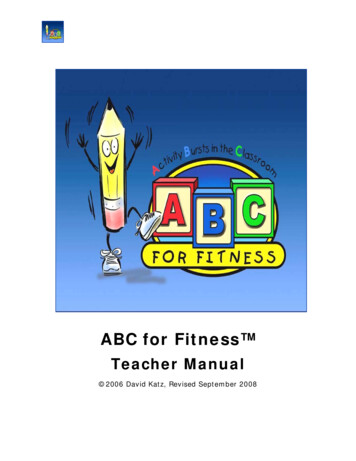
Transcription
ABC for Fitness Teacher Manual 2006 David Katz, Revised September 2008
ABC for Fitness Teacher Manual 2006 David Katz, Revised September 2008Dr. David Katz, MD, MPH, FACPM, FACPand the ABC for Fitness Development TeamPhysical Activity Consultant:Marvin Christley, MS, New Haven Public SchoolsContributing Editor:Jean Mee, EdDPhysical Education & School Health Education ConsultantConnecticut State Department of EducationOther Team Members:Catherine Katz, PhDDeborah Kennedy, PhDJudy Treu, MS, RDAllison Cuomo, BSJohn DeBlasio, BSWith special thanks to elementary school administrators and teachersin the Independence School District in Missouri for their ideas and suggestionsAdditional thanks to the Michigan Department of Educationfor permission to use Brain Breaks learning activitiesand to the North Carolina Department of Public Instructionfor permission to use Energizers Classroom-Based Physical ActivitiesABC for Fitness graphic was designed by Chris WrinnPhotographs were provided by Marvin Christley and John DeBlasioDrawings of children exercising were used with the permission of Phil Black,inventor of FitDeck cards (available from the website http://fitdeck.com)ABC for Fitness 1 2006 David Katz, revised September 2008
A-B-C For Fitness Activity Bursts in the ClassroomDear Teachers and School Administrators,At this time when childhood obesity is epidemic, and what used to be “adult onset” diabetes isoccurring with increasing frequency in children under age 10, our kids need regular physicalactivity more than ever. But pressures on schools - in part related to the federal No Child LeftBehind legislation - are causing reductions, not increases, in daily physical activity. In other words,No Child Left Behind is leaving more and more of our kids ON their behinds, all day long!Physical activity is vital for children’s health. It is also vital for their attentiveness andconcentration. As a parent of 5 children myself, I know all too well that young children can berestless and rambunctious. They need to move. Rambunctiousness is a normal, healthy childhoodcondition- and calls out for recess, not Ritalin. It is perhaps no coincidence that as daily physicalactivity levels decline, the diagnosis of attention deficit hyperactivity disorder is made with everincreasing frequency.But how do we reconcile our children’s needs for regular activity, with the needs of schools todedicate as much time to possible to teaching? How, in other words, do we reconcile the square pegto the round hole? By whittling the peg, or re-drilling the hole, of course! Enter ABC for Fitness .Inspired by my own son, Gabriel, who at the time was 5 years old, ABC for Fitness is a programdesigned to convert wasted time in school into productive, health-promoting activity bursts. Theprogram is based on the amount of time TEACHERS say they typically waste during the school dayin disciplining restless or inattentive children. By breaking activity into short “bursts” that can bedelivered right in the classroom throughout the day, ABC for Fitness provides teachers a meansto dissipate the restless energy of their pupils; keep the children alert and focused; and neverinterfere with teaching time. In fact, since creative teachers, and the training manual, haveapproaches to teaching during the activity bursts, teaching time can increase with this program.ABC for Fitness is offered to schools at no cost in dollars. It comes at no real cost in time. Andit can be in addition to any other physical education program a school may provide. The program isintended to promote health and fitness; enhance concentration and the behavioral environment inthe classroom; and help optimize academic performance.As a parent, I will be deeply gratified if children in your school benefit from ABC for Fitness. And Gabriel will certainly be pleased and proud of himself!With all best wishes,David L. Katz, MD, MPH, FACPM, FACPDirector, Yale Prevention Research CenterFounder, ABC for Fitness Programwww.davidkatzmd.comABC for Fitness 2 2006 David Katz, revised September 2008
ContentsChapter 1: Overview .5Chapter 2: Planning for Activity Bursts .9Welcome to ABC for Fitness Why is Physical Activity Important?Managing Activity Bursts and the Physically Active ClassroomClassroom Space DiagramsAddressing Potential ChallengesGeneral Tips for ExerciseChapter 3: The Basics of Activity Bursts 15Components of an Activity BurstGeneral Instructions for Activity BurstsCustomizing the Activity Bursts for Your ClassroomVarying the Number and Length of Activity BurstsStretches (Including Muscle Chart)Core Activities (or Warm-ups or Cool-downs)Chapter 4: Activity Burst Selection. 30Selecting Activity Bursts to Meet Your NeedsGeneral Activity Bursts for Fitness3132Basic Activity BurstsRefer to Chapter 3GradesK-532Advanced Activity BurstsMorning RoutineWigglesExercise MarchTake Five for FitnessCircuit TrainingThe 12 Days of FitnessSports GaloreGradesK-5K-5K-5K-52-52-52-532Activity Bursts of ImaginationImaginative Ideas for Warm-Up/Cool-DownABC for Fitness ChantBursts to the Beat (Using Music)Let’s SwimAs IfOn the FarmIt’s a Zoo in HereGradesK-5K-5K-5K-5K-3K-2K-239ABC for Fitness 3 2006 David Katz, revised September 2008
Activity Bursts for Learning and Fitness44What is Physically Active Learning?(Introduction)44Language ArtsAlphabet Body ShapesAir WritingOver, Under, Around, and ThroughStop and ScribbleFrozen Vocabulary25 StoriesStory TellSentence Shape-UpRelay What You LearnGradesK-2K-2K-22-52-53-53-54-54-545Social StudiesCompass PointsGeography StretchImpersonate the StateLiving HistoryGrades2-52-54-54-553MusicMove to the FrontOld McDonaldMarching BandGradesK-2K-2K-557MathNumbered Wall TouchesInches, Feet and Yards, Oh My!Math and MovementMath StationsGrades1-31-41-53-560ScienceLeaf LineSpace JamPlanetary FitnessJump Start Your HeartIn a HeartbeatGradesK-51-34-54-54-564HealthGo Bananas!Heart SmartWhat’s for Dinner?GradesK-23-53-570Chapter 5: Resources . 73Physically Active Learning ResourcesMusic ResourcesPedometersFit Deck Jr. cardsABC for Fitness 4 2006 David Katz, revised September 2008
Chapter 1OverviewABC for Fitness 5 2006 David Katz, revised September 2008
Welcome to ABC for Fitness !What is ABC for Fitness ?ABC for Fitness is a school physical activity program for elementary school students. It helpstake the time that teachers spend getting restless children to settle down, or distracted students toconcentrate – and convert this into structured, productive bursts of supervised physical activity.What is the mission of this program?Our mission is to provide a fun, simple, engaging, no-cost, effective program that encouragesphysical activity in the classroom. By breaking physical activity into short sessions, ABC forFitness enables most children to accumulate at least 30 minutes of physical activity each day.By increasing daily physical activity for children, ABC for Fitness can help promote health andfitness, while contributing to efforts to combat the spread of childhood obesity and diabetes, andrelated health conditions. ABC for Fitness increases physically active time during the school daywithout decreasing - and possibly even increasing! - the time dedicated to teaching.Will ABC for Fitness take away from classroom learning time?Research shows that school-based physical activity does not compromise children's academicperformance students or standardized test scores, even if it takes away time from other academicsubjects.1-5 By combining creative teaching techniques with structured activity bursts, ABC forFitness can actually offer the opportunity to increase teaching time each day.Is ABC for Fitness intended to replace physical education classes?ABC for Fitness is designed to fit physical activity into small intervals throughout the schoolday. It is intended to supplement, rather than replace, physical education programs in schools.We encourage classroom and physical education teachers to collaborate in offering physicalactivity in their respective settings in ways that complement each other.Which schools can benefit from ABC for Fitness ?All schools can benefit from this program. Schools unable to make time for formal physicaleducation classes can make time for ABC for Fitness. And since the program is available freeof charge, schools unable to fund physical education programs can afford ABC for Fitness. Can ABC for Fitness be tailored to meet the needs of schools?ABC for Fitness is designed to offer “activity bursts” performed for a few minutes at a time,adding up to a baseline level of 30 minutes of activity per day. For example, your school couldchoose to offer 5 sessions per day averaging about 6 minutes each. Activity bursts of slightlyshorter or longer length, and slightly fewer or more in number, are perfectly acceptablevariations on the theme and should be tailored to suit your needs.We recommend that your school first determine, through informal or formal polling, how manyminutes of “down time” that teachers experience with their students during classroom sessions.That becomes the “straw” that you can turn into “gold”! Use that amount of time - 4 minutes, 6minutes - as the period for each activity burst. Then distribute the bursts throughout the day.ABC for Fitness 6 2006 David Katz, revised September 2008
Why is Physical Activity Important?Physical activity provides many benefits that can positively affect children’s health, their mentaland social well-being, and their performance in the classroom.First and foremost, physical activity can greatly benefit children’s health. In the U.S., childhoodobesity has become a major concern. Since the early 1970s, average weight has been steadilyincreasing among children from all socioeconomic levels, racial and ethnic groups, and regionsof the country.6 Recent data shows that 17% of US children and adolescents are now overweight(at or above the 95th percentile of gender-specific body mass index for age growth charts).7If a more inclusive definition of overweight were applied to children, it’s likely that 50% or moreof children in the US would qualify! The rate of childhood obesity is a true crisis.8, 9The increase in childhood overweight has been accompanied by higher levels of weight-relatedconditions such as Type 2 diabetes, high blood pressure, sleep apnea, gallstones, and depression,6The incidence of type 2 diabetes among adolescents, though still not high, has increased by afactor of more than 10 in the past two decades.6 For children born in the U.S in 2000, the lifetimerisk of diabetes is estimated to be about 1 in 3 for males and 2 in 5 for females.10Less than a generation ago, “type 2” diabetes was called “adult onset” diabetes because it wasunknown in children. It is now increasingly common in children under the age of 10.Physical activity can play a key role in combating the growing epidemics of obesity and diabetes.It contributes to weight loss and helps prevent obesity. It strengthens muscles and makes themmore flexible. It strengthens the capacity of the lungs to breathe. In addition, it may help reducethe risk for heart disease, Type 2 diabetes, and certain cancers.Prevention is the key to avoiding the onset of inactivity-related conditions and diseases. Whileexercise is an important antidote to overweight and obesity, as well as depression and low selfesteem, preventing these problems from occurring in the first place is an even better strategy.The experience of most adults will confirm that it is easier to keep moving than to get movingafter long periods of inactivity. It is easier to maintain a healthy body weight than to fight backagainst overweight and obesity. These truths apply to young people, too. Engaging in physicalactivity during childhood increases the chance of remaining physically active as an adult.Along with its roles in helping to keep children healthy, prevent chronic conditions, and developan active lifestyle, physical activity has many other benefits. It can reduce the effects of stress,while at the same time stimulating brain activity and increasing the ability to concentrate.Reducing stress can make it easier for children to develop physically, mentally, intellectually,and socially. Ultimately, this may help them perform better in the classroom.In addition, exercising in a group setting with other children can instill a sense of belonging. Itcan also help them develop important life skills such as taking turns, sharing, and cooperatingwith others. This in turn can have a positive effect on the classroom environment.ABC for Fitness 7 2006 David Katz, revised September 2008
References for Chapter 11.Ahamed Y, Macdonald H, Reed K, et al. School-based physical activity does not compromise children'sacademic performance. Medicine & Science in Sports & Exercise, 2007; 39 (2):371-376.2.Carlson SA, Fulton JE, Lee SM, et al. Physical education and academic achievement in elementary school: datafrom the Early Childhood Longitudinal Study. American Journal of Public Health,10.2105/AJPH.2007.1171763.Dwyer T., Blizzard, L., and Dean, K. Physical activity and performance in children. Nutrition Reviews, 1996;54(4 part 2):S27-31.4.Sallis J, McKenzie T, Kolody B, et al. Effects of health-related physical education on academic achievement:Project SPARK. Research Quarterly for Exercise and Sport, 1999; 70(2):127-134.5.Shephard, R.J. Habitual physical activity and academic performance. Nutrition Reviews, 1996; 54(4 part 2),S32-S36.6.Ludwig DS. Childhood obesity: the shape of things to come. New England Journal of Medicine, 2007;357:2325-7.7.Ogden CL, Carroll MD, Curtin LR, McDowell MA, Tabak CJ, and Flegal KM. Prevalence of overweight andobesity in the United States: 1999-2004. Journal of the American Medical Association, 2006; 295(13):1549-55.8.Katz DL, O'Connell M, Njike VY, Yeh MC, and Nawaz H. Strategies for the prevention and control of obesityin the school setting: systematic review and meta-analysis. International Journal of Obesity (London), 2007;July 31 [Epub ahead of print].9.Katz DL. Obesity.Be Dammed! What it will take to turn the tide. Harvard Health Policy Rev. 2006; 7:135151.10. Venkat Narayan KM, Boyle JP, Thompson TJ, et al. Lifetime risk for diabetes mellitus in the United States.Journal of the American Medical Association, 2003; 290:1884-1890.ABC for Fitness 8 2006 David Katz, revised September 2008
Chapter 2Planning for Activity BurstsThe purpose of this manual is to serve as a guideline for simple, yet enjoyable, ways to increasechildren’s health. It is written from the perspective that the activities described will be conductedunder appropriate adult supervision in controlled environments at all times. The author cannotidentify all situations and/or risks to which participants might be exposed as they engage in theseactivities. Users are, therefore, cautioned that there is no substitute for common sense and an ongoing alertness and that they are ultimately responsible for ensuring the safety of children’sactivities so that they might reap the benefits of this program in a safe and enjoyable fashion.ABC for Fitness 9 2006 David Katz, revised September 2008
Managing Activity Burstsand thePhysically Active ClassroomActivity bursts and physically active learning should be engaging and fun! A natural by-productof physical activity is a certain level of noise. However, it is unnecessary and unacceptable forchildren to run around the classroom screaming and talking loudly. The occurrence of loud andunruly behavior is an indicator that the purposes of the activity bursts and physically activelearning are not being met. Students have learned the routines and behavior standards forcooperative group learning and activity centers in classrooms, and similar routines and standardsmust be established for this approach as well.Activity bursts are, by definition, short episodes of physical activity and exercise. Routines forengaging in activity should be commensurate with the time dedicated to the burst. For example,students are given succinct directions for a brief physical activity. Gross motor activity isstimulating and, understandably, children will become excited. Consideration and planningshould include a cool-down (see General Tips for Exercise in this chapter) to accommodate thephysiological slowing down of heart rate, oxygen flow, and generation of adrenaline andendorphins. Classroom routines such as collection and distribution of materials, straightening oflearning centers, or other student-managed tasks, are ideal for this purpose.Planning for physically active learning in the classroom should include (1) consideration forneighboring classrooms, (2) rearranging of classroom furniture, (3) realistic and safe movementwithin the available space, and (4) routines that empower students to manage themselvesappropriately within the time and space. Some physically active schools designate a specificschedule for physical activity and physically active learning (for example, during the first fifteenminutes of every hour).Just as planning for any other learning is sequenced for progression and developmentalappropriateness, planning for Activity Bursts in the Classroom and the overall physically activelearning environment should be similarly planned. Increases in duration and intensity ofphysically active learning episodes should be progressive and incremental, and behavioralexpectations and learning purposes should be clearly communicated to students. Consequencesfor failure to meet behavioral expectations should also be clearly defined and applied in aconsistent and timely manner.When teachers and students have learned to manage physical activity in the classroom, thelearning environment will become an engaging and enjoyable one for both students and teachers.ABC for Fitness 10 2006 David Katz, revised September 2008
Classroom Space DiagramsIf space in the classroom is an issue based on your current layout of desks, you may want torearrange the desks to provide more space for students to move in the classroom. Below are fourexamples of alternative layouts that should prove conducive to offering ABC for Fitness activity bursts. Before trying any of these, please make sure that your school policy allows you toreconfigure the classroom space.Staggered FormationHorseshoeTeacher DeskTeacher Desk student deskCluster Formation available spaceTight-Row FormationTeacher DeskTeacher DeskAdapted from On the Other Side of the Wall: Physical Education Activities in Limited Space and Classrooms by William T Price,Program Coordinator, University of South Florida School of Physical Education, Wellness, and Sport Studies. Posted on the internet in2002 with credits given to the Tampa Metro Civitan Club. Accessed from the website /wall/wall.html on 6/14/07.ABC for Fitness 11 2006 David Katz, revised September 2008
Addressing Potential ChallengesPotential ChallengeStrategyLimited classroom spaceORNo option of rearranging desks Cost Time Students’ reluctance to participate Transitioning back to learning Students’ boredom with bursts ABC for Fitness 12Have children stand behind their desksand jog or hop in place.Have the children run around the schoolbuilding on a nice day.Have the children walk quietly down thehall with alternating high knees.Set up 4 stations in each corner of theroom. Post a picture of 1 activity at eachstation. Send ¼ of the class to eachstation, and switch every minute.The ABC for Fitness program is free.Any equipment mentioned in this manual(such as pedometers) is optional.You can raise funds for any optionalequipment if you want to use it.The amount of time it takes to calm/discipline “energetic” children is basicallythe amount of time it takes to have thechildren perform a burst of activity.Consider ABC for Fitness a “healthy”tradeoff for your students.If several short bursts seem like toomuch, vary the number and length ofbursts.Some individual students may bereluctant to participate due to lethargy,shyness, or feeling self-conscious.Do not punish these students or bringundue attention to them. Over time, theymay become more involved in the bursts.If the class takes awhile to settle downafter the bursts, try these suggestions:o End with a “silent burst” whereeveryone is quiet.o Vary the type of music used. Forexample, try classical music.o End with a variation on “Simon Says”such as “Do as I’m doing, follow me;walk back to your seats slowly,follow me.”o Turn the lights down after the burst.o Ask students to direct their attentionto their breath as they graduallyslow down and catch their breath.Vary the stretches and bursts.Have students take turns leading them.Add music, or vary the music that youalready use. 2006 David Katz, revised September 2008
General Tips for ExerciseHere are some tips to encourage healthy exercise and minimize the risk of injury.1. Warm-upA warm-up is a lower-intensity or lower-speed activity used to prepare for an athletic event orexercise session. It helps decrease the risk of injury, along with the risk of muscle sorenessthat may occur after exercise. The goal is to increase circulation around the body whilepreparing the body for the workload to come. It makes muscles pliable, while escalating thedelivery of oxygen and nutrients to muscles by increasing blood flow. Lastly, warming upprepares your muscles for stretching, which is the next tip to come.What you need to know about muscle sorenessMuscle soreness is unlikely with these brief bursts of activity. However, it helps tounderstand what muscle soreness is in case any students ask about it.There are two common kinds of exercise-related muscle soreness: Acute soreness can occur during or immediately after exercise. It often goes awayafter 1-2 minutes of rest. If it goes away, you can continue to exercise. If discomfortpersists, you should stop. Delayed soreness usually occurs 24 to 36 hours after a workout. It can happen tosomeone who is not used to a lot of activity, or a new type of activity. It is part of anormal response as the body adapts to exercise. Once the muscles recover, thisprocess can lead to greater muscle strength.Muscle soreness is most likely to occur after trying a new exercise or activity or with anincrease in intensity, frequency or duration of exercise. To reduce the soreness, avoidworking the same muscle groups on consecutive days and add low-intensity exercise,such as walking, to your workout. If soreness lasts for more than 7 days, see a doctor.To help prevent or minimize delayed soreness, include a warm-up and cool-down. Youcan allow time for muscles to adapt to activity by gradually increasing physical activityover a few days.REFERENCES: Ask a Fitness Specialist: Delayed Muscle Soreness after Exercise: What Causes It? 2006, MayoClinic Staff. Accessed on the website www.mayoclinic.com/health/muscle-soreness/AN00933 on4/9/08. Michael Ross. Delayed-Onset Muscle Soreness: Work Out Now, Pay Later? The Physician andSportsmedicine Vol. 27, Issue 1 (January 1999). Accessed on the websitewww.physsportsmed.com/issues/1999/01 99/muscle.htm on 4/9/08.ABC for Fitness 13 2006 David Katz, revised September 2008
2. StretchingStretching is extending your body to achieve a healthy range of flexibility. The goal is toallow you to move with a greater extent of motion through increasing joint mobility andstability. Stretching is also used to prevent injuries of the hamstring, quadriceps, calf, etc. Itcan help muscles to lengthen, which will make it easier to exercise and perform other dailyactivities. Stretching reduces muscle tension, enhances muscular coordination, and delaysonset of muscle fatigue. After a good warm-up and quality stretch, it’s time to start theexercise at hand.3. Aerobic exerciseHealth experts advise that children get a total of at least 1 hour of aerobic exercise a day. Itshould be preceded by a warm-up, and followed by a cool-down.For the purpose of ABC for Fitness , aerobic exercise is any activity that increasesbreathing and heart rate. Under ideal circumstances, you should aim for at least 30 minutesof aerobic activity during the school day. In addition, you should include a brief warm-upprior to each activity burst, and cool-down when the activity burst is completed.4. Cool-downThe purpose of a cool-down is to slow your level of physical activity gradually, from highintensity to low intensity. It should follow aerobic exercise. It helps the heart rate andbreathing return to normal, prepares muscles for the next activity, and helps prevent musclecramps or spasms. A cool-down will also provide time for the entire class to calm down,settle back into their seats, and be ready to learn.5. Fluid intakeDrinking plenty of water is extremely beneficial for overall health. Water helps maintainproper muscle tone while eliminating wastes and toxins from the body. Water also relievesconstipation and is essential for a healthy lifestyle. It may be appropriate for children todrink 4 to 6 fluid ounces of water after an activity burst. It should be readily available ifneeded for any children who are thirsty.6. Classroom safetyThis program is designed to be safe in any classroom. Before starting the activity bursts,arrange desks, tables, and other various objects in a way that will allow free movement ofyour students relative to these objects and other students. For ideas on how to arrange yourclassroom, please refer to the classroom space diagram on page 11.ABC for Fitness 14 2006 David Katz, revised September 2008
Chapter 3The Basics of Activity BurstsABC for Fitness 15 2006 David Katz, revised September 2008
Components of an Activity BurstUnder ideal circumstances, you should aim for a total of at least 30 minutes of activity burstsduring the school day. Each activity burst should have 3 components: a warm-up that includes stretching/and or low intensity activity a core activity that increases breathing and heart rate a cool-downEach time a new burst is performed, you may select a new warm up, core activity, and cooldown. Here are some examples.A. Warm-Up (see pp. 19-21 for stretches and pp. 22-29 and 39 for other activities)This can include stretching and/or low intensity activity. Here are some examples:StretchesHamstring stretchQuadriceps stretchBack stretchTriceps stretchNeck stretchCalves stretchLight aerobic activityWalkingArm circlesB. Core Activity (see p. 22-29)Here are some sample activities that can count as the core activity. Make sure thestudents maintain a high intensity for the duration of the core activity.Strength activitiesHop scotchBear walkSquat thrustsLungesSquatsArm circlesStar jumpsAerobic activitiesSkippingJoggingSlidingGallopingJumping in place or around roomWalking quicklyHopping on 1 footDancing to musicC. Cool-Down (see pp. 19-21 for stretches and pp. 22-29 and 39 for other activities)This may include stretching and/or low intensity activity. It is designed to help thestudents calm down, settle into their chairs, and be ready to learn. As part of the cooldown, you may also ask students to be still and pay attention to their breath (see“Watch Your Breath” at the bottom of page 39).ABC for Fitness 16 2006 David Katz, revised September 2008
General Instructions for Activity Bursts Select an activity burst for the class to follow. In the beginning, or when using a new activity,you can copy the picture and place it on the wall or chalkboard for the children to see.Start with a warm-up. Examples are stretching, walking in place, or a slower version of theactivity burst that you have selected.Increase the speed and intensity of the activity. This is the core of the activity burst.Cool down after the high-intensity activity. Examples are walking in place, or a slowerversion of the activity burst.If any children are thirsty, offer them water to drink.Customizing the Activity Burstsfor Your ClassroomYou may switch the intensity level based on the behavior of the class during a particular activityburst. As you know from your own teaching experience, classes can differ from one year to thenext in terms of their behavior and the amount of classroom management required to deal withbehavior issues. In addition, students can vary in terms of overall levels of fitness; this may beespecially true at the time you first start to lead the activity bursts.To accommodate the average fitness and behavior level among students at any given time, referto the chart below. This chart provides guidance for varying the time spent on warm-ups, activitybursts, and cool-downs based on classroom needs.Intensity Levels:Intensity levels are general indicators of how long students should perform the warm-up, coreactivity, and cool-down, based on the class’s overall levels of fitness and behavior.1. Low fitness levels and/or restlessStudents primarily are not very athletic and/or are generally very restless.2. Average fitness levels and/or on task 75% of the timeStudents are of average athletic ability and/or are rather well behaved.3. High fitness levels and/or very well behavedStudents are very athletic and/or are very well behaved.INTENSITY LEVEL1. Low fitness / restless2. Average fitness / on task3. High fitness / well-behavedABC for Fitness ACTIVITY COMPONENTSOptions to combine warm up, core activity,and cool downABCWarm-UpCore ActivityCool-Down1 minute2 minutes3 minutes1 minute3 minutes2 minutes30 seconds5 minutes30 seconds17 2006 David Katz, revised September 2008
Varying the Number and Lengthof Activity BurstsABC for Fitness is designed to be offered as approximately 5 activity bursts of approximately6 minutes each. However, if this option does not work on a given day, you may want to adapt thelength and number of activity bursts to suit your needs, as long as they a
of charge, schools unable to fund physical education programs can afford ABC for Fitness. Can ABC for Fitness be tailored to meet the needs of schools? ABC for Fitness is designed to offer “activity bursts” performed for a few minutes at a time, adding


